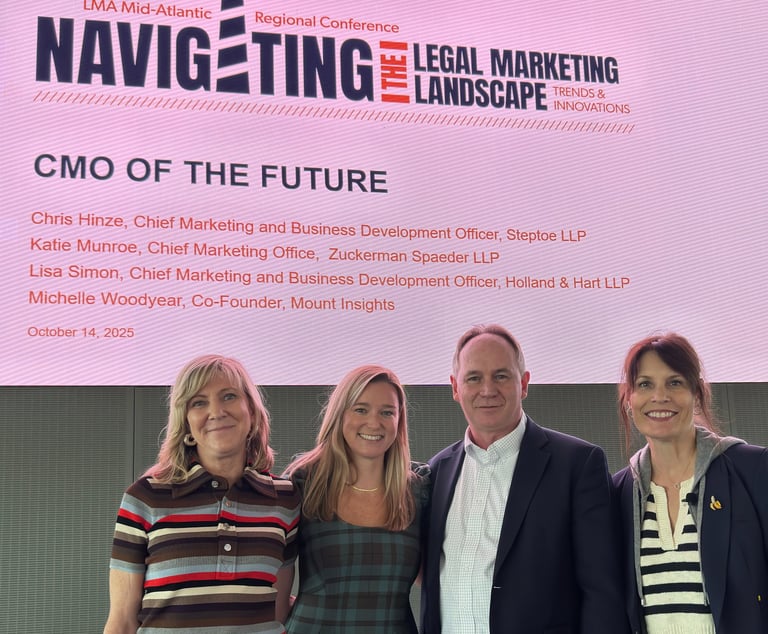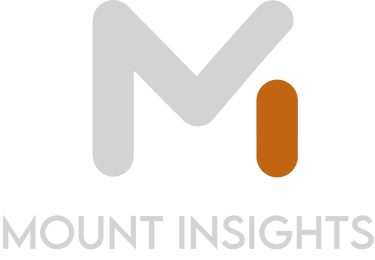
The CMO of the Future: How Law Firm Leaders Are Reimagining Change
Michelle Woodyear
The CMO of the Future: How Law Firm Leaders Are Reimagining Change


Insights from the LMA Mid-Atlantic Regional Conference panel featuring CMOs from Steptoe LLP, Zuckerman Spaeder LLP, and Holland & Hart LLP
Panelists:
Chris Hinze, Chief Marketing and Business Development Officer, Steptoe LLP
Katie Munroe, Chief Marketing Officer, Zuckerman Spaeder LLP
Lisa Simon, Chief Marketing and Business Development Officer, Holland & Hart LLP
Moderator: Michelle Woodyear, Co-Founder, Mount Insights
Leading Through Transformation
The legal industry is evolving faster than ever. AI, data analytics, pricing models, and client-value initiatives have accelerated expectations across every function. But the hardest part of transformation isn't the technology—it's the people.
At the LMA Mid-Atlantic Regional Conference, three CMOs shared how they're guiding change within their firms. Each represented a different size and structure, yet their perspectives revealed a shared truth: lasting transformation depends as much on empathy and perseverance as it does on strategy and systems.
It was the last session before happy hour, and moderator Michelle Woodyear set the tone: "We're the only thing standing between you and a cocktail." What followed was an honest, funny, and deeply practical conversation about what modern legal marketing leadership really looks like.
Superpowers: What Sets These Leaders Apart
Before diving into strategy, Woodyear asked each panelist to share their professional "superpower"—the defining strength that shapes their leadership approach.
Chris Hinze credited his years managing high-stakes communications and reputational issues at a global law firm. "My superpower is remaining very calm in difficult situations," he said. That pragmatic composure flows through to how he leads in his role at Steptoe.
Katie Munroe described her ability to frame communications in ways that resonate—being direct but empathetic in what she produces. "It's something I try to bring to every conversation," she noted, a skill that's proven essential in her boutique litigation environment.
Lisa Simon, with 30 years in the industry, shared her love for structured experimentation. "I love to throw things in the sandbox and see what happens," she said. "But I also know the importance of creating good swim lanes—so there's freedom within a framework."
These superpowers—composure, clear, empathetic communication, and creative structure—would emerge as recurring themes throughout the discussion.
Chris Hinze: Building Systems for Consistency and Connection
When Chris Hinze joined Steptoe LLP as Chief Marketing and Business Development Officer, he stepped into an environment where the team had not had leadership for some time. His goal was to rebuild the team and create greater consistency and collaboration across all marketing and business-development functions.
"Individuals can get myopic. Event teams focus on events, PR focuses on press, BD focuses on pitches or submissions," he said. "The challenge is helping people step back and see the larger picture."
Hinze's leadership philosophy centers on providing freedom to work rather than control. "When people understand the direction we are heading in, you don't have to micromanage," he explained.
Becoming Strategic Connectors
One of Hinze's key challenges—and opportunities—is helping team members break out of their specialist silos to think more strategically. He's focused helping people make connections and have the necessary tools—both within their own teams and across the firm. "It's about giving them room to do their jobs while helping them see how their work fits into the larger strategy," he said.
M&BD team members should see themselves as connectors—professionals who stretch across practice groups and understand how the pieces fit together. "You might be the only person who sees the whole map," he reminded the audience. "Lawyers billing 1,800 to 2,200 hours a year simply don't have time to make all those connections themselves."
He also emphasized the fundamental importance of understanding the business at a deeper level. "One of the most valuable things marketing professionals can do is develop genuine curiosity about what our lawyers do all day and the industries their clients operate in," he said. "Most of us weren't brought up to be lawyers or specialize in these areas, but that's exactly why being intentionally curious about the business creates such value. When you understand not just the legal work but the client's industry context, you become a true strategic partner."
Partnering Across Business Functions
At Steptoe, that clarity extends into partnership with other business functions. The team works closely with the firm's client-value and pricing team to use data and client research to inform pricing, messaging, and business-development priorities.
This integrated approach demonstrates how marketing can move beyond supporting tactics to supporting firm strategy. By partnering closely with the client value function, there is a role there in articulating the value propositions that support the firm's financial objectives while strengthening client relationships.
The result is a marketing organization that emphasizes transparency, collaboration, and shared purpose across disciplines.
Katie Munroe: Turning Conversations Into Strategy
For Katie Munroe, Chief Marketing Officer of Zuckerman Spaeder, leadership starts with listening. When she joined the boutique litigation and investigations firm, she found an entrepreneurial culture defined by agility and individual initiative. She saw an opportunity to help channel that energy into shared growth planning while keeping the firm's independent spirit intact.
"We began with conversations, not templates," she said. "I'd sit down one-on-one with lawyers, talk about what energized them, what they wanted more of, and how they saw their practice evolving. Then I'd summarize what I heard and share it back" with the intention of developing a tailored marketing, business development, and profile-raising plan that played to each person’s strengths.
Those conversations evolved into a firm-wide planning process—flexible enough for individuality but consistent enough to align firm strategy. "Five years in, now every partner has a plan for their business development and marketing," she noted. "It's created clarity, focus, and strategic alignment across the firm. The consistency came from collaboration, not mandate."
Building Strategic Relationships Through Curiosity
Munroe emphasized the importance of genuinely understanding what makes lawyers proud of their work. "Attorneys are passionate about what they do," she observed. "I have yet to encounter one [attorney] who's not excited to share what's special about their practice, what makes them proud of what they're doing for clients. You immediately build goodwill and allegiance by asking questions about their practices."
That curiosity extends beyond individual relationships to pattern recognition across the firm. "Look for patterns—what have we learned from this client? What can we share? What's the thread? You're connecting dots, recognizing how to harness trends that can help to fuel practice. Can we learn from what one client is experiencing and apply it to others we're working for? The dividends from that practice are immediate."
Using AI as a Learning Partner
Munroe is also shared how AI fits into her approach: as an accelerator of understanding, not replacement for it.
"I use ChatGPT every day—for better or worse," she laughed. "Recently I was curious how such a tool would describe our firm chair, so I typed in her name. It produced helpful insights with language pulled from sources beyond our own website, including independent third-parties. It gave me vocabulary to pitch her in a way I hadn't previously considered."
She suggested other uses: "Ask ChatGPT to compare tour chair to chairs of the other top five litigation boutiques in the country, and I know I’d get back something helpful in terms of how they differentiate themselves. The same translates to industry definitions or practice group positioning. It's a great jumping-off point."
Munroe's approach—equal parts curiosity, empathy, and structure—has helped her turn dialogue into direction while strengthening relationships across the firm.
Lisa Simon: Guiding Change With Empathy and Precision
Lisa Simon, CMO at Holland & Hart, has spent more than 30 years leading marketing and business development at law firms across the country. Her perspective on innovation is pragmatic and optimistic: change, she believes, succeeds when it feels both safe and purposeful.
"I like to test ideas quickly, but within a framework that keeps people comfortable," she said. "If you give talented teams the right environment, they'll surprise you with their creativity."
Simon describes her approach as "structured experimentation." She focuses on reading the firm's tolerance for change and adjusting her pace accordingly. "You may be hired to accelerate transformation," she observed, "but part of leadership is pacing it. Progress sticks when people believe in it."
Creating Strategic Value Through Better Questions
Simon encourages her team to think strategically by asking the question behind the question. When a partner requests something—a report, a pitch, an event—her team doesn't just deliver. They pause to understand why. "That small shift turns marketing from reactive to strategic," she said.
She's equally committed to creating feedback loops, encouraging her team to ask what worked, what didn't, and how "fine" can become "exceptional." She shared a concrete example of how her team produces valuable charts and data, but by creating a feedback loop—asking questions like "What should people focus on first?" or "What's the key takeaway here?"—they've been able to make the insights even more impactful. "That dialogue has helped us move from fine to the next level."
Her attention to empathy and process has made her particularly effective at turning small initiatives into broader shifts—updating internal platforms, refining processes, or improving collaboration tools in ways that build trust and momentum.
Understanding the Economics of Legal Services
Simon also highlighted a growing opportunity for marketers: fluency in the economics of law. "Understanding how pricing, profitability, and client value work is the next frontier," she said. "Lawyers think they sell hours, but what they're really selling are solutions. Once marketing starts speaking that language, our influence expands dramatically."
She offered practical advice for those at firms without dedicated pricing functions: "Work backward from the data you have—to determine the value clients are placing on the services you’re providing. How quickly are they paying invoices? How much work is being written off before the bill is sent?" Understanding how realization, leverage and profitability impact client relationships is essential.
The goal, she explained, is bringing thoughtful recommendations to partners: "If realization is low and we're not having success with cross-selling, maybe we stop investing there and focus on clients we really enjoy working with who are paying at the rate they should be."
For Simon, effective leadership isn't about personality or flash—it's about empathy, patience, and the confidence to guide teams through change one achievable step at a time.
Becoming Indispensable: Lessons for the Next Generation
The panelists agreed: leadership isn't defined by title. Every marketing and BD professional has the potential to drive change from where they sit. Their advice for becoming indispensable to firm leadership was straightforward—and tested by experience.
Be curious about the business
Learn what your lawyers do, what their clients care about, and how the firm makes money. "Curiosity builds credibility," Munroe said. "It shows you're invested in the same outcomes as the lawyers you support."
Hinze added a reality check: "Partners consistently tell me, 'My BD person or marketing person doesn't understand what I do all day.' Most of us weren't brought up to be firm lawyers or specialize in these areas. But the solution is simple: be voraciously curious. Read the news. Look for patterns. Ask questions."
And don't be intimidated. As Simon noted: "Lawyers from one practice area have no hesitation saying 'I have no idea what you do' to another lawyer. We should feel empowered to ask the same questions."
Understand the economics
Get comfortable with realization rates, profitability, and pricing models. "When marketing can speak the language of financial performance," Simon said, "we move from support to strategy."
The airline analogy resonated: "Think about being on a plane—every single person paid a different price for their seat because there was some value associated with whatever price they paid. The same applies to clients. Different clients are willing to pay different amounts, and we need to figure that out. The data is going to uncover it."
Ask smarter questions
All three emphasized the power of inquiry—whether it's asking "why" before acting or using feedback loops to move from fine to exceptional. Asking thoughtful questions builds trust, deepens understanding, and turns service into strategy.
"Just asking 'Is this what we're looking for?' after delivering something starts to change the culture," Simon noted. "We're already seeing practice group leaders and others in leadership starting to understand the value of feedback loops."
Be the connector
As Hinze reminded the audience, marketing professionals often have the widest view of the firm's relationships. Spot patterns, introduce colleagues, and share insights across practices. "You might be the only person who sees the whole map," he said.
"Look for patterns, recognize how trends relate to different practices, and connect those dots," Munroe added. "You're going to make yourself valuable very quickly—both to your team members and to the people you report to."
Communicate with empathy
Every CMO on the panel tied success to understanding—of the business, of personalities, and of change itself. The best marketing teams, they agreed, are not just creative but trusted, because they lead with respect for how people adapt and grow.
Each panelist underscored how progress in their firms is a shared effort built on trust, curiosity, and collaboration.
A Shared Vision for the Future
As Woodyear asked in closing, "What magic can happen when it all comes together?"
Three CMOs, three very different firms—and one unifying philosophy: change is relational before it is operational.
Hinze builds alignment through structure and clarity. Munroe builds trust through conversation and curiosity. Simon builds progress through experimentation and empathy. Together, they represent the modern blueprint for legal marketing leadership: calm, connected, and data-literate—but above all, human.
Their message to emerging leaders was simple but powerful: you don't have to sit in the C-suite to lead. Anyone who asks better questions, connects the dots, understands the business, and approaches colleagues with curiosity is already doing the work of the CMO of the future.
Because in an era defined by AI, analytics, and acceleration, the greatest differentiator remains the oldest one: people who know how to guide other people through change.
